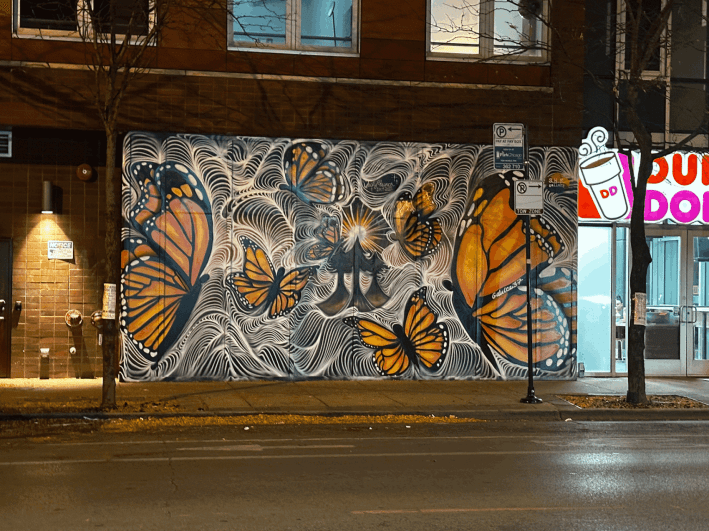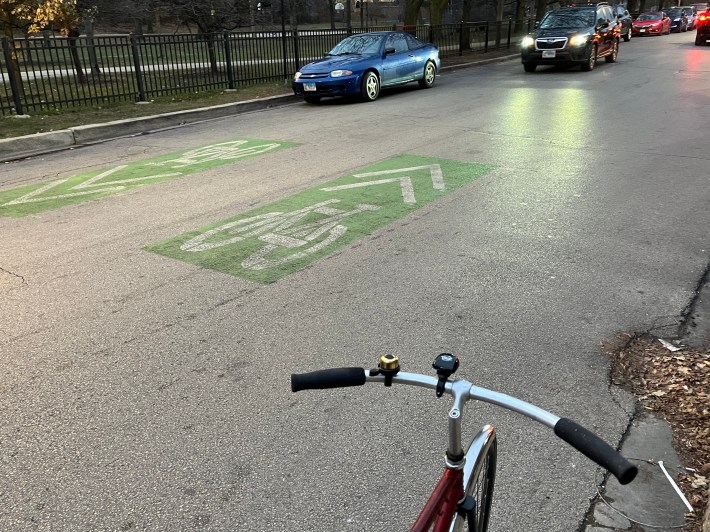
By Victoria Malis
Want to get more involved with promoting sustainable transportation in Chicagoland next year? Here are some initiatives you might consider getting involved with.
Volunteer to do walk audits on the Southwest Side
Regular Streetsblog readers probably know the expressions "pedestrian islands," "push-to-walk crossing signals" (aka "beg buttons,") and "protected bike lanes with flexible plastic posts." One fall Thursday night, five people grouped next to a hand-written sign "MPDC" (McKinley Park Development Council) on Ashland Avenue went through this terminology and put names to visually familiar concepts.
The people peering in their screens, scrutinizing the difference between a painted median and a hard barrier, didn’t bring any prior knowledge to the table. What they did bring is their willingness to invest time and effort into making their neighborhood a better place to walk, bike, and live. The group gathered for an organized neighborhood walk in Pilsen led by the development council.
This fall, MPDC organized seven neighborhood walks to inspect the walkability and bikeability of streets in Bridgeport, Chinatown, McKinley Park, and Pilsen. Each walk started with a brief demonstration led by an MPDC representative who explained the daunting terminology. A few minutes later volunteers scattered in pairs and examined assigned blocks. An online form prompted them to respond to multiple choice questions about sidewalk and crosswalk conditions, and provide pictures and comments.

"One of the things we'll do with the data from the walk audit is to build maps of the best ways to and from the river," McKinley Park Development Council President Council Kate Eakin said. "And also places where we need improvement." Developed with assistance from the National Park Service, the questionnaire will inform a new wayfinding system that will help direct Southwest Side residents to Bubbly Creek. That's the South Fork of the South Branch of the Chicago River that runs from the river almost to Pershing Road, between Ashland and Racine avenues.
So far volunteers have covered over 24 percent of the targeted 500 blocks, according to Eakin. This means that organized walks are likely to return with warm spring weather. In the meantime, residents can inspect a nearby block on their own time and fill out the form, which is available online. Eakin emphasized that each block should have its own form submission, and it’s necessary to walk both sides of the street in an attempt to capture any infrastructure gaps. The neighborhood walk guidelines can be accessed on the MPDC’s website.

If residents see a misplaced street sign, a snowdrift on a bike lane, or a pothole, MPDC and Chicago Department of Transportation advise them to call 311 or submit a service request online for a faster resolution. Data gathered from the neighborhood walks will be used for longer-term enhancements and advocacy efforts.
This summer MPDC published a framework plan that aims to achieve a continuous riverwalk along Bubbly Creek, a waterway that is often overlooked. The neighborhood walks contribute to moving that project along, demonstrating community involvement in the effort to improve access to the creek.
These walk audits are one of the ways that Southwest Side residents can influence the City to "shift transportation dollars," as Active Transportation Alliance Director of Community Building and Leadership Maggie Czerwinski calls the wider movement.
According to a 2023 National Association of Realtors survey, 78 percent of American respondents indicated they would be willing to pay more to live in a walkable community. Streetsblog USA did a deep-dive on relevant studies and national walkability trends last year highlighting small policy changes that could help achieve the 15-minute city vision.

Become an Active Transportation Alliance Street Team Advocate
ATA's Street Team Advocate initiative teaches volunteers how to improve walk/bike/transit in Chicagoland. They show up in person or join online to develop necessary advocacy skills in a series of free specialized workshops and lectures. People from a wide variety of backgrounds attend: lawyers, marketing specialists, the jobless (it's a great resume builder), students, and people who work in the government, Czerwinski said, adding that most of them are young people.

Legal literacy is another pillar that the Active Transportation Alliance training sessions help develop. As part of the 2024 Street Team Advocate program, the group hosted deep dives on the Clean and Equitable Transportation Act that calls for transit reform and a reduction in greenhouse gases emission. The schedule for 2025 will be published on Active Transportation Alliance’s social media accounts in the near future.
Get involved with Project Sidewalk research
A free learning opportunity that the Active Transportation Alliance has already scheduled for next month is a training on how to virtually map out barriers to using sidewalks and bicycling. Two training sessions on January 9 and January 16 will be held under the umbrella of the Chicago’s branch of Project Sidewalk, a joint effort of ATA and the University of Illinois Chicago. Project Sidewalk collects data to determine locations in American cities that need accessibility upgrades, which will be helpful for designing future accessibility maps and other tools.
Another way to get involved in promoting sustainable transportation in our state is the 2025 Illinois Walk Bike Summit, May 7-8 in Springfield. Previously focused exclusively on Illinois cycling, this year the biennial summit will expand to include issues of walkability.

Propose a Neighborhood Greenway in your neighborhood
Finally, if you're interested in getting a new Neighborhood Greenway pedestrian-and-bike-priority side street route in your community, Chicago Department of Transportation Communications Director Erica Schroeder has some advice. She suggested reaching out to the local ward office. "Residents who want a greenway in their neighborhood can advocate by highlighting how it could improve connections to local destinations, enhance access to parks or trails, or offer a safer alternative to nearby high-traffic streets," she said.
Victoria Malis is a Medill Investigative Lab reporter and an MSJ candidate at Northwestern University. Reporting on transportation and infrastructure on Chicago's Southwest Side, she has contributed to IL Latino News, Block Club Chicago and Streetsblog Chicago. Prior to pivoting to journalism, Malis earned a bachelor's degree in economics from University of California San Diego and worked in data analytics in New York City.

Did you appreciate this post? Streetsblog Chicago is currently fundraising to help cover our 2025-26 budget. If you appreciate our reporting and advocacy on local sustainable transportation issues, please consider making a tax-deductible donation here. Thank you!





